When we think of camping, initially, we think of the $20 campsite reservation and assume that camping is the cheapest of all accommodation options. Camping can be super cheap, but only if you go camping frequently. If you are camping only twice a year, then you might actually save money staying in a hotel!
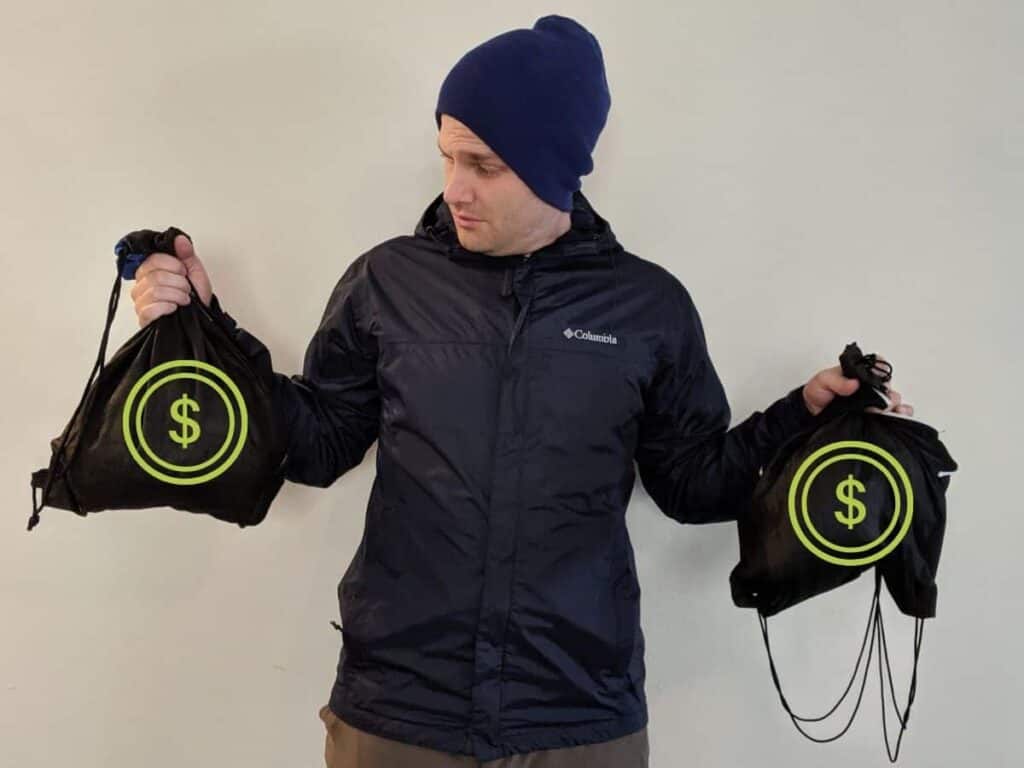
What are the total costs to go camping? For a family of 3: Experienced campers who already have gear can expect to spend from $150 to $250 for a 2 day camping trip. Campers without camping gear can spend anywhere from $300 to $3000+ depending on the type of camping trip (backpacking, ultralight, mountaineering, car camping, etc), the amount of improvised or borrowed camping gear, and the quality of gear.
So what could possibly be so expensive? I really think the question is interesting and so I have done a lot of research into the price of the different items that people take camping, and I made a very thorough spreadsheet you can use for your own planning that you can find here.
By the way, as an Amazon Associate, I earn when buying qualified products through links on my site.
In this post, I’ll breakdown the costs so you can easily see where the bulk of the cost is coming from, so you can find where you can save money.
If you prefer, I talked through some scenarios and showed some of the spreadsheet also in a YouTube video:
Scenario 1:
Two Night Car Camping Trip
Fall
Family of 2 Adults, 1 Child
The Jepsons With No Camping Gear
The Jepsons are a hypothetical family with no camping gear, but they want to get into camping and they want to make sure it’s a positive experience, so they are willing to spend a little bit more on camping gear up front. A family with no camping gear that wants decent quality gear can easily spend over $1600 on their first camping trip.

Let’s break down these costs.
Activities
This family is planning on going on a cave tour, where kids get in free, which brings the total to $30.
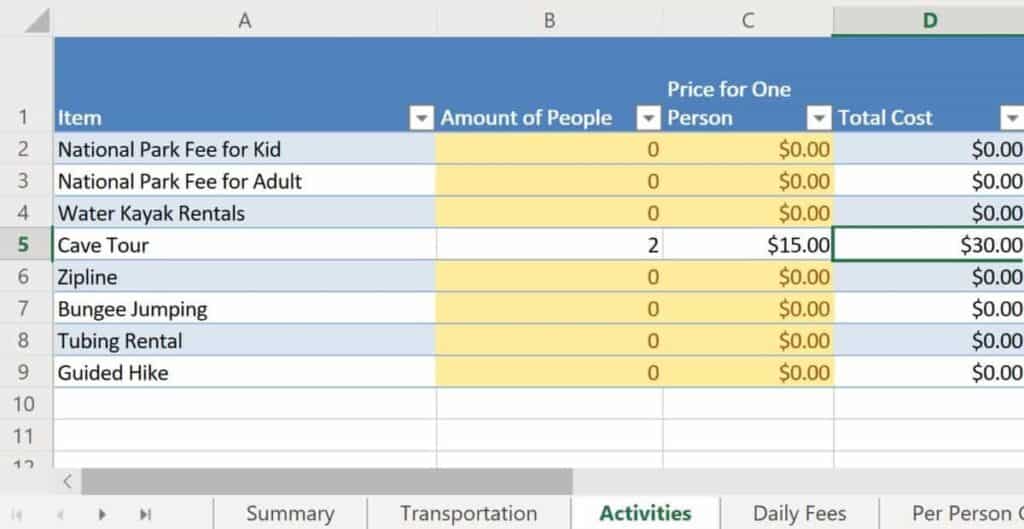
Unless you own all your gear, you can spend a decent amount of money on adventure gear rental in one trip. Especially if your trip is longer than a week, the cost of activities can be a significant part of your trip. For this trip, though, the price difference is negligible.
A note about activity cost… it can be these activities can be the most memorable part of your trip. It can be tempting to cut out the activities to save money, and while it’s a great idea to find affordable and off-the-beaten path things to do, if a great experience costs some money, you will likely not regret it.
Transportation
The campground is a little over an hour drive from The Jepsons’ house. We can add the costs together here:
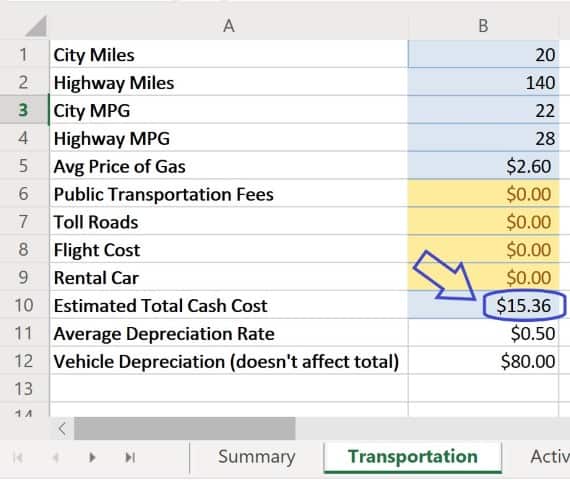
The vehicle depreciation expense doesn’t affect the total, but it is an interesting statistic if you wanted to consider the total cost of a big road trip.
Food
Food is probably one of the most difficult to estimate, since you likely have some things in your kitchen pantry that you can use for your trip. To take a simplistic guess, we are assuming $3 per person for breakfast, $4 per person for lunch, and $7 per person for dinner, with $3 per person for snacks.
Snacks can be much more expensive, actually, depending on what you decide to bring.
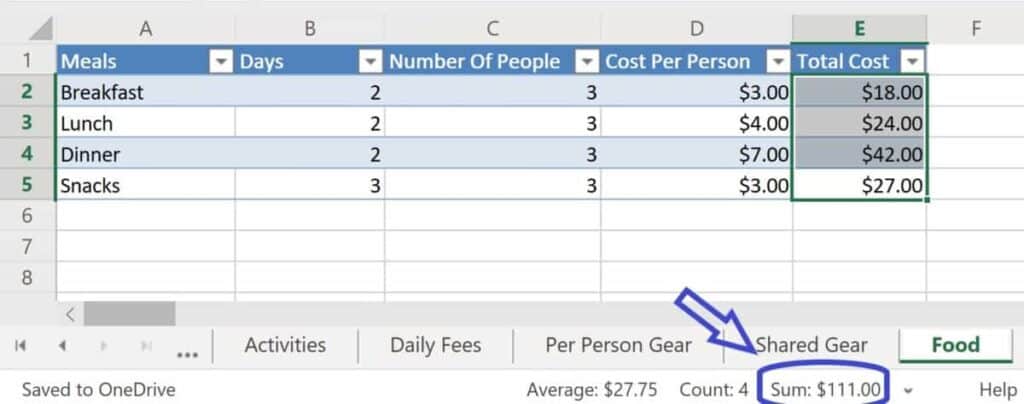
The total amount of money spent on food for 2 adults and 1 child is going to land around $111.
Daily Fees
Since this family is just getting into camping, they have opted to not purchase the parks pass that allows free entry so they have to pay the daily fees.
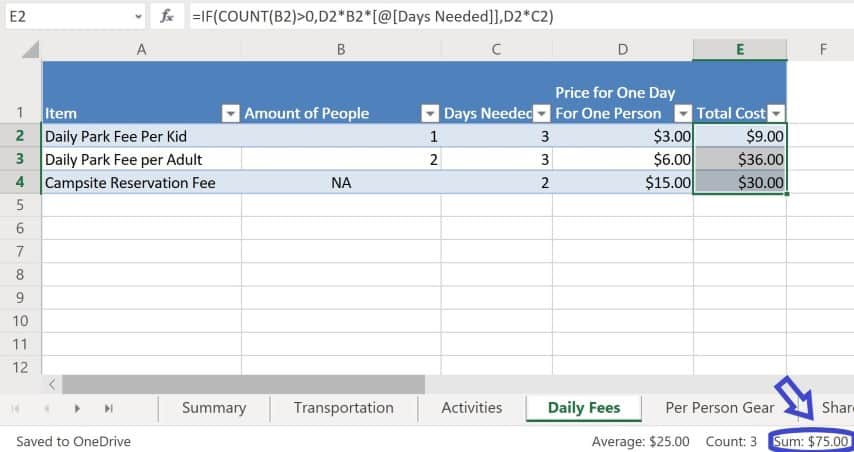
Daily fees are inconsequential if you are only with one other person, but they can quickly add up if you are with a large group. The total cost for the campsite and the daily fees comes up to $75 for the Jepsons.
Shared Gear
As part of planning for camping, there is one category of stuff to bring that everyone will use. The Shared Gear category. Not everyone will wear the same socks, but everyone will be using the same tent in this group.
This is a list of shared gear that the Jepsons are going to buy. The Jepsons want to buy this gear specifically for camping, so they are going to buy extra even if they already have some of this at home.
| Shared Gear Item | Planned Price |
| Paper towels | $1.00 |
| Matches/Lighter | $2.00 |
| Cooking Oil/Butter | $3.00 |
| Sun screen | $3.00 |
| Bug spray | $4.00 |
| Tissues | $4.00 |
| Wet Wipes | $4.00 |
| Water jugs | $5.00 |
| Extra Batteries (for headlamps, various electronics) | $5.00 |
| Gas Fuel (propane/butane) | $5.00 |
| Can Opener | $5.00 |
| Tongs | $5.00 |
| Dishsoap | $6.00 |
| Spatula | $7.00 |
| Cooking Pan | $10.00 |
| Pocket knife | $10.00 |
| Tarp | $10.00 |
| Cutting board and knife | $10.00 |
| Extra Blankets | $10.00 |
| Spices, salt&pepper, hot sauce | $10.00 |
| Wood | $12.00 |
| Medical Kit | $15.00 |
| Roasting Sticks (marshmallows, hot dogs) | $15.00 |
| Camping Bin to Store Camping Gear | $20.00 |
| Camping Table | $30.00 |
| Mess kit | $30.00 |
| Camp stove | $45.00 |
| Cooler | $50.00 |
| Dayhike Bag/Backpack | $50.00 |
| Family Tent | $100.00 |
| Total | $486.00 |
These prices are not exact, but they are in the range of prices that you can expect for each item. My camping budgeting spreadsheet has an estimated price range for each item to help in budgeting.
As you can see, the small gear adds up, with the most expensive piece of equipment being the tent. This is a family of 3, and so they are not getting a gigantic tent–you can definitely spend more (and less) money, and it gets a little complex because of all the variety.
Buying a tent is a tricky affair, since there are so many options and types of tents. If you are wanting to decide on how much money to spend on a tent, click here to see the Tent Prices Guide that I wrote in effort to help figure out what type of tent you need as well as the price range you can expect and should shoot for.
The Jepsons are opting to buy the cooking gear, including a cheaper camping stove, including a spatula, spices, oil, and a small frying pan for camping.
Some of the more expensive items are the day hike backpack (on the cheaper side), the camp stove, the cooler, and the mess kit. The mess kit is a kit that includes plates and bowls for a the family, and includes all cutlery.
This list of shared gear is completely reasonable and is actually still on the conservative side. You can expect to pay more for larger groups, and for bigger/nicer tents.
Per Person Gear
This is the most expensive part of the camping budget. Clothing, bedding, especially shoes can add a lot to the total cost.
| Per Person Item | Quantity Needed | Total Cost |
| Toiletries (deodorant, toothbrush, etc) | 3 | $9.00 |
| Hats | 1 | $10.00 |
| Kids Sleeping Pad | 1 | $10.00 |
| Kids Thermal Underwear | 1 | $20.00 |
| Camping Pillows | 2 | $30.00 |
| Kid Hiking Shoes | 1 | $30.00 |
| Kids Jackets | 1 | $30.00 |
| Water Bottle | 3 | $30.00 |
| FlashLight/Headlamp | 2 | $40.00 |
| Kids Sleeping Bags | 1 | $40.00 |
| Mens Jackets | 1 | $50.00 |
| Mens Thermal Underwear | 1 | $50.00 |
| Womens Jackets | 1 | $50.00 |
| Womens Thermal Underwear | 1 | $50.00 |
| Adult Sleeping Pad | 2 | $60.00 |
| Trek Poles | 2 | $60.00 |
| Mens Hiking Shoes | 1 | $80.00 |
| Womens Hiking Shoes | 1 | $80.00 |
| Camp Chair | 3 | $90.00 |
| Adult Sleeping Bag | 2 | $180.00 |
| TOTAL | – | $999.00 |
The Jepsons are planning on buying thermal underwear for everyone since this camping trip is in the fall, and it’s projected to get a bit chilly (down in the 50 degree range) at night. Also, the Jepsons do have some warm jackets, but none that are waterproof and made for the outdoors, so they are opting to purchase new jackets for everyone.
There is definitely a premium for outdoor clothing–mostly because outdoor clothing is meant to withstand rain and wind and many are designed to be lightweight, which makes camping clothing more expensive.
The Jepsons are also planning on buying all the bedding–the sleeping bags and pads. They didn’t get the nicest sleeping bags, but they found bags with temperature ratings that should handle their fall camping trip.
Additionally, since the Jepsons are planning on going on a day hike on the 2nd day, they want to buy hiking shoes for the family including trekking poles for the adults.
In total, the Jepsons will be spending $999 total for everyone’s gear.
To Sum Up
The Jepson family will be spending $1686.36 on their first camping trip.
Ways The Jepsons Could Save Money Camping
Sound like a lot of money? Camping is certainly not free. But it’s worth it! Thankfully, there are a few key ways that the Jepsons can save some money.
Money Saving Tips for First Time Car Campers
- Borrow the most expensive items: As you can see, in the shared gear, the most expensive item was the tent, the cooler, and a day hike backpack. According to the 2017 Camping Report, that 14% of survey participants borrowed a tent, 8% borrowed a cooler, and 8% borrowed a sleeping bag. If you are new to camping, borrow these most expensive items so you can try before you buy and save some money.
- Settle for cheaper gear: This can get a little tricky–there are some types of gear that if you buy cheap, then you will be replacing that gear soon enough and you will end up spending more money. Some gear, such as sleeping bags, are not nearly as critical to have the highest quality if you are going to be car camping (camping within sight of your car), since you can easily supplement your bedding with blankets from home.
- Substitute camping gear with housewares you have at home. The Jepsons don’t need to get a travel bottle of cooking oil just for camping–they can find a small used water bottle and use some of the cooking oil from home. The places to substitute that will save the most money are bedding and clothing.
- Try hiking before you buy hiking shoes. If you are just getting into hiking and you’re not sure what to buy to prepare, make sure and plan for a smaller route (just a few miles), and use your running or tennis shoes you wear normally. Hiking shoes can be quite expensive, and the cheaper models notoriously will fall apart in no time. If it turns out you love hiking and you find yourself going often, then you can start investigating whether you want to spend money on hiking shoes. (It turns out that many people just hike in their running or trail shoes indefinitely)
If the Jepson family borrowed the following:
- 2 Adult Sleeping bags
- 2 Adult Sleeping pads
- Cooler
- Tent
And skipped out on:
- Hiking shoes
- Trekking poles
- Camp Chairs
And substituted with things from home:
- Camping Pillows — Pillows from home
- Mess Kit — Paper plates
- Day hike backpack — old college backpack
Then the final price for the Jepson family would be closer to:
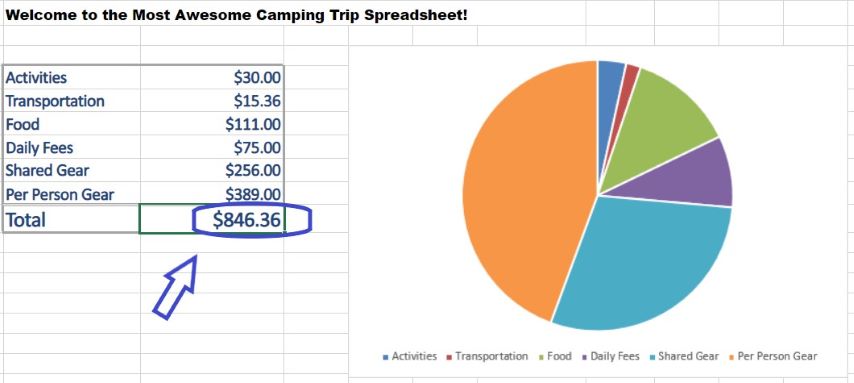
$846.36 Still a lot– there’s still more that the Jepson family could do, but this just illustrates how a couple of adjustments can save a lot of money.
The Hansen Family With No Camping Gear on a Strict Budget
The Hansen family isn’t sure they are going to love camping (which they will soon change their mind!), and so they are opting to spend as little as possible.
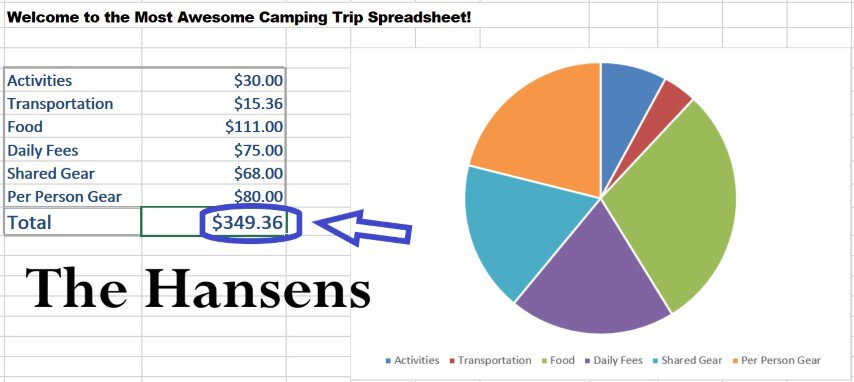
So the Hansen Family is planning on spending just under $350. How can this be done? Let’s check it out.
Activities
Activities are staying the same. Don’t want to miss out on that cave tour!
$30 for both adults (kid gets in free)
Transportation
For comparison’s sake, we are going to assume the Hansens and the Jepsons are next door neighbors, and are the same distance from the campground. Also, they drive the same car model and year, so the mileage is the same.
Total fuel costs: $15.36
Food
The Hansens and the Jepsons have the same number of people in their family, so the projected cost will be the same.
Total food costs for the Hansens: $111
Daily Fees
Daily fees are going to be the same as the Jepsons, as the Hansens also do not have a parks pass.
Total Daily Fees: $75
Shared Gear
This is where the Jepsons and the Hansens are going to be very different in their approach. This is the same stuff that the Jepsons brought, but the Hansens are going to improvise.
| Shared Gear Item | Price or Plan |
| Paper towels | Bringing from Home |
| Matches/Lighter | $2 |
| Cooking Oil/Butter | Using some vegetable oil in a small used water bottle |
| Sun screen | $3 |
| Bug spray | $4 |
| Tissues | Bringing tissues from home supply |
| Wet Wipes | Doing without (everyone’s just going to be a little stinky) |
| Water jugs | Filling used Simply Lemonade jugs with tap water |
| Extra Batteries (for headlamps, various electronics) | Doing without |
| Gas Fuel (propane/butane) | Doing without |
| Can Opener | Bringing from home kitchen |
| Tongs | Bringing from home kitchen |
| Dishsoap | Bringing from home kitchen |
| Spatula | Bringing from home kitchen |
| Cooking Pan | Bringing oldest pan from home kitchen |
| Pocket knife | Bringing from home kitchen |
| Tarp | Borrowing from Jepsons |
| Cutting board and knife | Bringing from home kitchen |
| Extra Blankets | Bringing from home supply |
| Spices, salt&pepper, hot sauce | Bringing from home kitchen |
| Wood | $24.00 (bringing more wood since they are not buying a stove) |
| Medical Kit | $15 |
| Roasting Sticks (marshmallows, hot dogs) | Found some pointy sticks in their backyard |
| Camping Bin to Store Camping Gear | Using the cloth grocery bags |
| Camping Table | Depending on the campground picnic table |
| Mess kit | Bringing from home kitchen |
| Camp stove | Doing without |
| Cooler | $15 –getting a cooler from a Thrift Store |
| Dayhike Bag/Backpack | Using an old college backpack |
| Family Tent | Borrowing from the Jepsons |
| Total | $68.00 |
Some of the sacrifices are trivial, but some of them are going to be less comfortable. It’s important to know that there is always a trade-off. Part of the fun though of camping is to learn how to live a bit more simply and figure out how to make things work and adapt.
Borrowing
Borrowing a tent and tarp from the Jepsons will work great for the first trip, eventually the Hansens will want their own since borrowing requires special care so as to not damage their friend’s tent.
Cooking over the campfire
Additionally, cooking over a campfire is a fun experience, but depending on the meal, it can be more challenging to get the right temperatures and cook everything through. A camp stove definitely leads to more of a consistent eating experience since you can control the temperature much more easily.
Lastly, if you are going to be doing a lot of camping, it’s actually much easier on the wallet to use a gas stove then to always have to purchase wood. You’ll be spending at least $10 on wood every time you go camping per night (if you are using your campfire to cook with)–which is less efficient than burning gas (but arguably more fun).
Using camp supplies from home supplies
Since the Hansens don’t want to spend a lot of money, they are trying to avoid buying a lot of camping specific gear. This is a great thing to do for your first or second time camping, but this is also a sacrifice, since you will be having to displace your kitchen and home stuff when you go camping. If you are like me, then this means you may be losing sunscreen and other random items and then you end up buying more than you actually need.
It’s simpler to dedicate your camping gear to just camping, so you don’t have to dip into your home resources.
Per Person Gear
Again, the Hansens are going to be improvising a lot more to keep costs low
| Per Person Item | Price or Plan |
| Toiletries (deodorant, toothbrush, etc) | Bringing from home supply |
| Hats | Using sweatshirts with hoods |
| Kids Sleeping Pad | Bringing child’s pillows and blankets from home |
| Kids Thermal Underwear | Bringing extra layers for kid to wear |
| Camping Pillows | Bringing pillows from beds |
| Kid Hiking Shoes | Using regular tennis shoes |
| Kids Jackets | Relying on sweatshirt and one of those cheap ponchos they have in the closet |
| Water Bottle | Bringing disposable water bottles |
| FlashLight/Headlamp | Using smartphone flashlights |
| Kids Sleeping Bags | Bringing lots of extra blankets |
| Mens Jackets | Bringing sweatshirts and long sleeves |
| Mens Thermal Underwear | Layering long sleeve clothing |
| Womens Jackets | Bringing sweatshirts and long sleeves |
| Womens Thermal Underwear | Layering long sleeve clothing |
| Adult Sleeping Pad | Using blankets for padding |
| Trek Poles | Will pick up a walking stick if needed |
| Mens Hiking Shoes | Using tennis shoes |
| Womens Hiking Shoes | Using tennis shoes |
| Camp Chair | Using campground picnic tables and logs for seating |
| Adult Sleeping Bags (2) | $80 –Bringing extra blankets to compensate cheaper sleeping bags |
| TOTAL | $80 |
Again, there are some sacrifices in comfort, specifically in that the Hansens will be hauling much more to their campsite to compensate for not having lightweight camping gear. Since they are car camping, this isn’t a big deal, though, and they’ll have a great time.
To Sum Up
The Hansens will be spending around $349.36 for their two night camping trip.
The Kramers With All The Camping Gear
The last family in scenario 1 are the Kramers. The Kramers are pro campers, and except for a new headlamp they need to buy, they have all the camping gear already, so they just need to pay for the cost of the trip, the reservations, and the food.

It looks like the Kramers are going to get away with spending only $193.36! Let’s see how that’s done.
Activities
Activities are again staying the same.
$30 for both adults for the cave tour(kid gets in free)
Transportation
To keep things simple, still, the Kramers live right next to the Hansens and the Jepsons and are the same distance from the campground. Also, they drive the same car model and year, so the mileage is the same.
Total fuel costs: $15.36
Food
Total food costs for the Kramers: $111
Daily Fees
The campsite reservation fee is the same, but the Kramers have a yearly park pass, which means they don’t have to pay daily park fees.
Total daily fees for the Kramers: $30
Shared Gear
| Shared Gear Item | Price |
| Wood | $12 |
| Extra Batteries | $5 |
| Total | $17 |
Per Person Gear
The Kramers just need a new headlamp to replace a broken one.
| Per Person Gear | Price |
| Headlamp | $20 |
| Total | $20 |
To Sum Up
The Kramers will be spending $193.36 for their two day camping trip for their family of 3.
Much more reasonable, right? Food was the most expensive item for this camping trip, and this can also be made more efficient if snacks are not purchased but made at home.
How Much Does It Cost For a 2-day Car Camping Trip?
As you can see, the answer varies. First time car campers can spend upwards of over $1600 if they buy all the gear outright. As the Hansens have shown, though, you can substitute the majority of the camp gear and borrow what you need to get started without issues. A family camping for the first time can spend $350 for everything they need and substitute the rest.
If you already have the gear, you can spend under $200 for a 2-day trip including food, or less if you’re really good at keeping food costs down.
Scenario 2:
3 Day Backpacking Trip
Summer
4 Adults
Katie and Friends With No Backpacking Gear
Katie and her 3 friends go camping frequently, but they have never organized their own backpacking trip. They are not planning on buying ultralight (the lightest and most expensive type of backpacking gear) but they are trying to buy gear of sufficient quality and minimum weight.
Since Katie and her friends want to get into backpacking, they are willing to invest the money so they can go more often.
In total, Katie and Friends are budgeting $2,720.71 for their first backpacking trip.
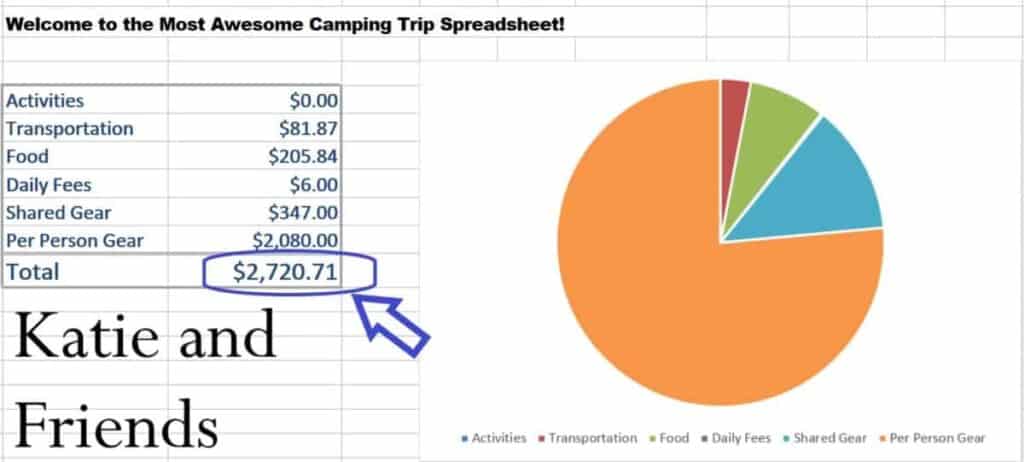
The main part of this cost is coming from the per person gear. If you divide the per person gear by 4 than each person would be responsible for $520 for all the backpacking gear (including sleeping bags, backpacking tents, etc).
Important, they are not buying all the camping gear because they already have many things that will work for their backpacking trip. They just don’t have any backpacking specific gear so that’s what this section focuses on.
Let’s dive into the costs to see where that money is going.
Activities
The activity is hiking and camping, and there are no other activities planned.
Total cost for activities: $0
Transportation
The location for this backpacking excursion is over 400 miles away, and requires Katie and her friends to wake up really early to get to the trailhead on time.
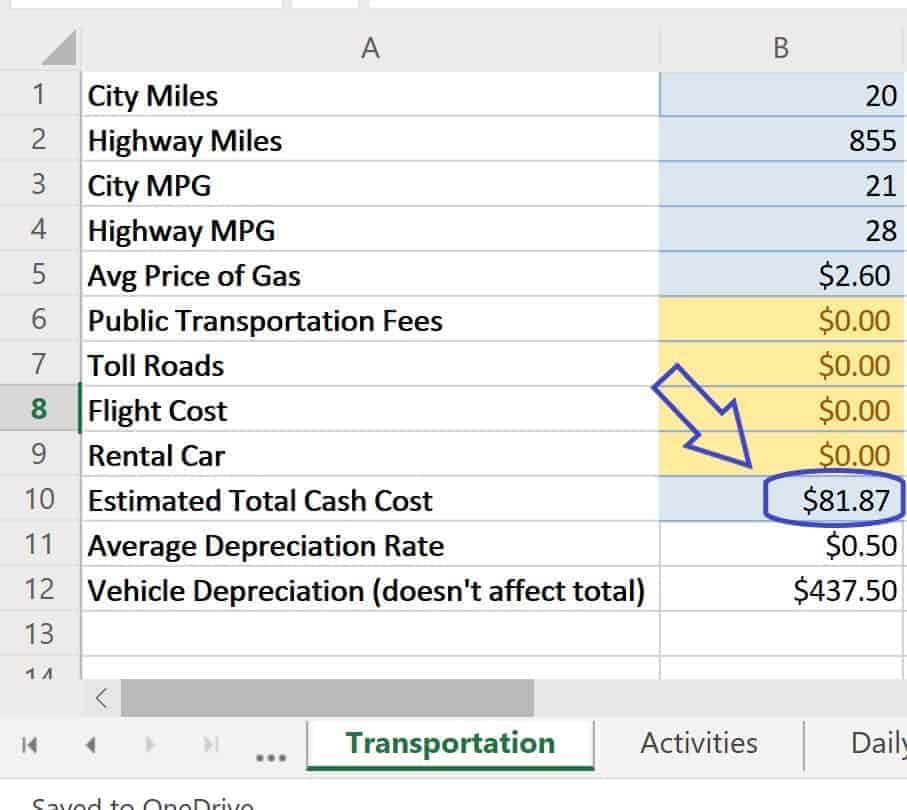
Total fuel costs: $81.87
Food
Food for backpacking excursions are much more complicated to plan for since you need to plan carefully with foods that will have adequate calories since backpacking is so intensive. Not only that, but many times pre-prepared dehydrated backpacking food comes at a premium. Mountain House (see price for 6 pouches on Amazon), for example, are a very popular brand of dehydrated food used by backpackers because of its light weight.
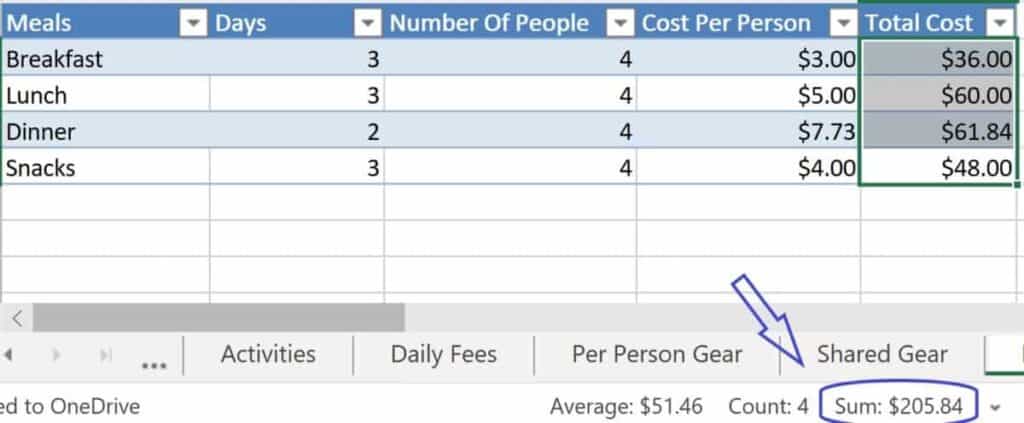
Total food costs for Katie and Friends: $205.84
Daily Fees
The trailhead has a money drop box that asks for $2 per group per day.
Total daily fees for Katie and Friends: $6
Shared Gear
| Shared Gear Item | Price |
| Dry Bag | $15.00 |
| Camp stove | $80.00 |
| Gas Fuel (propane/butane) | $20.00 |
| 4-person Mess kit | $50.00 |
| Tarp | $26.00 |
| Dishsoap | $6.00 |
| Medical Kit | $30.00 |
| Shovel | $10.00 |
| Water Purification System | $110.00 |
| Total | $347.00 |
Per Person Gear
| Per Person Gear Item | Quantity Needed | Total Cost |
| Camping Pillows | 4 @ $15 | $60.00 |
| Water Bladder | 4 @ $25 | $100.00 |
| Adult Sleeping Pad | 4 @ $30 | $120.00 |
| 2-man Tent | 2 @ $100 | $200.00 |
| Hiking Shoes | 4 @ $100 | $400.00 |
| Adult Sleeping Bag | 4 @ $100 | $400.00 |
| Trekking Backpack | 4 @ $200 | $800.00 |
| Total | $2080.00 |
To Sum Up
Katie and friends will spend $2720.21 with their current plan.
Ways Katie and Friends Could Save Money On Their Backpacking Trip
Again, Katie and her friends have the option of borrowing big ticket items such as sleeping bags, backpacks, and tents to save money.
Another option is to settle for lesser quality gear.
This is tricky, since shoes, one of the most expensive pieces of clothing for backpacking, are incredibly important for a successful backpacking trip. If your shoes are uncomfortable, than you will have a miserable time backpacking. Having shoes with good arch support helps because you will be stepping on uneven surfaces thousands of times per day.
So, good shoes really makes a big difference in how your trip will go.
Cheaper sleeping bags means a sleeping bag that is either less warm, or heavier–both which are not as desirable for backpacking.
In short, using cheaper gear is always an option, but it comes at a cost, which I should mention many people do just fine with cheaper gear, they just usually have to carry more weight as a result.
How Much Does It Cost to Go Backpacking?
Depending on the distance from where you live, the length of the trip, and the number of people, and if you have all the backpacking gear already and you are good about your food, you can spend as little as $300 for a 3 day camping trip with 4 adults.
Depending on the gear purchased, the cost can go up to $3000 and beyond depending if you are choosing high quality/ultralight gear.
Conclusion
Hope that helps! There’s definitely a lot to plan for in a big camping trip–and the costs can vary widely depending on what gear you need. Feel free to check out my free spreadsheet if you want to make your own budget for your own camping trip.

